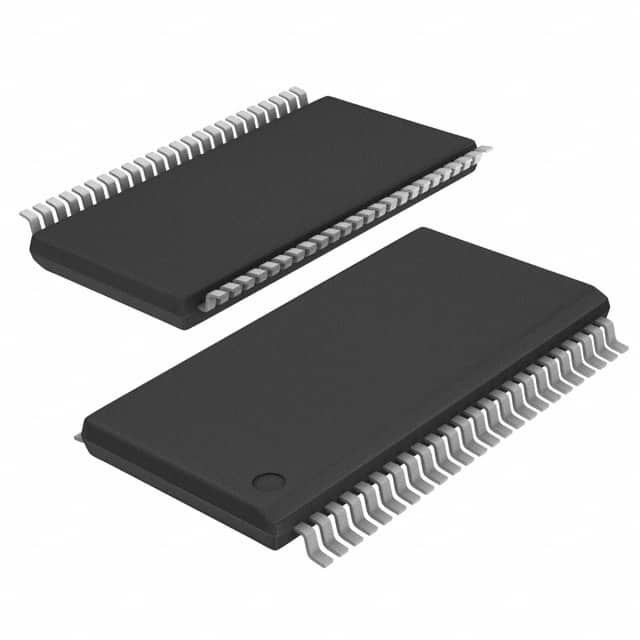SN74ALVTH162245VR
Product Overview
- Category: Integrated Circuit (IC)
- Use: Level Shifter and Bus Transceiver
- Characteristics: High-speed, low-voltage, 16-bit bidirectional transceiver
- Package: 48-pin Very Thin Quad Flat Package (VQFN)
- Essence: Transfers data between two independent buses operating at different voltage levels
- Packaging/Quantity: Available in reels of 2500 units
Specifications
- Number of Bits: 16
- Logic Family: ALVTH
- Voltage Level: Low-Voltage (1.65V to 3.6V)
- Input/Output Type: Bidirectional
- Operating Temperature Range: -40°C to +85°C
- Propagation Delay: 2.8ns (Max)
- Output Drive Strength: ±12mA
- ESD Protection: >2000V (Human Body Model)
Detailed Pin Configuration
The SN74ALVTH162245VR has a total of 48 pins, which are divided into four groups:
Group A (Pins 1-12)
- Pins 1-4: Data I/O (A1-A4)
- Pins 5-8: Data I/O (B1-B4)
- Pins 9-12: Voltage Supply (VCCA1, VCCA2, VCCB1, VCCB2)
Group B (Pins 13-24)
- Pins 13-16: Data I/O (A5-A8)
- Pins 17-20: Data I/O (B5-B8)
- Pins 21-24: Ground (GND)
Group C (Pins 25-36)
- Pins 25-28: Data I/O (A9-A12)
- Pins 29-32: Data I/O (B9-B12)
- Pins 33-36: Voltage Supply (VCCA3, VCCA4, VCCB3, VCCB4)
Group D (Pins 37-48)
- Pins 37-40: Data I/O (A13-A16)
- Pins 41-44: Data I/O (B13-B16)
- Pins 45-48: Ground (GND)
Functional Features
- Bidirectional data transfer between two buses with different voltage levels
- Supports voltage level translation from 1.65V to 3.6V
- Provides non-inverting level shifting for both input and output signals
- Allows simultaneous transmission in both directions
- Enables hot insertion and removal of devices without bus contention or data corruption
Advantages and Disadvantages
Advantages
- High-speed operation
- Low-voltage compatibility
- Bidirectional data transfer
- Non-inverting level shifting
- Hot insertion and removal support
Disadvantages
- Limited to 16-bit data transfer
- Requires careful consideration of voltage compatibility between buses
Working Principles
The SN74ALVTH162245VR is designed to facilitate the transfer of data between two independent buses operating at different voltage levels. It utilizes a bidirectional transceiver architecture that allows data to flow in both directions simultaneously.
The device incorporates non-inverting level shifting, ensuring that the logic high and low levels are maintained during the translation process. This enables seamless communication between systems operating at different voltage domains.
To prevent bus contention and data corruption, the SN74ALVTH162245VR features a tri-state output control. This allows the device to be effectively disconnected from the bus when not actively transmitting or receiving data.
Detailed Application Field Plans
The SN74ALVTH162245VR finds applications in various fields where voltage level translation and bidirectional data transfer are required. Some of the common application areas include:
- Communication Systems: Facilitating data exchange between different voltage domains in networking equipment, routers, and switches.
- Industrial Automation: Enabling communication between devices operating at different voltage levels in control systems and PLCs.
- Consumer Electronics: Supporting data transfer between components with varying voltage requirements in smartphones, tablets, and gaming consoles.
- Automotive Electronics: Facilitating communication between different subsystems and ECUs operating at different voltage levels in vehicles.
- Medical Devices: Enabling data exchange between medical equipment and sensors with different voltage specifications.
Detailed and Complete Alternative Models
- SN74ALVTH162244VR
- SN74LVC162245A
- SN74LVCH16245A
- SN74AVC16245DGGR
- SN74CBT16245DLR
These alternative models offer similar functionality and characteristics to the SN74ALVTH162245VR, providing options for different voltage ranges, package types, and pin configurations.
In conclusion, the SN74ALVTH162245VR is a high-speed, low-voltage bidirectional
Lista 10 Vanliga frågor och svar relaterade till tillämpningen av SN74ALVTH162245VR i tekniska lösningar
Sure! Here are 10 common questions and answers related to the application of SN74ALVTH162245VR:
Q: What is SN74ALVTH162245VR? A: SN74ALVTH162245VR is a 16-bit bus transceiver with 3-state outputs, designed for low-voltage (1.65V to 3.6V) applications.
Q: What is the maximum data transfer rate supported by SN74ALVTH162245VR? A: SN74ALVTH162245VR supports a maximum data transfer rate of 400 Mbps.
Q: Can SN74ALVTH162245VR be used in both input and output modes? A: Yes, SN74ALVTH162245VR can be used as both an input and output buffer.
Q: What is the purpose of the 3-state outputs in SN74ALVTH162245VR? A: The 3-state outputs allow multiple devices to share a common bus without interfering with each other.
Q: What is the voltage level compatibility of SN74ALVTH162245VR? A: SN74ALVTH162245VR is compatible with both TTL and CMOS voltage levels.
Q: Can SN74ALVTH162245VR be used in hot-swapping applications? A: Yes, SN74ALVTH162245VR supports hot-swapping, allowing it to be inserted or removed from a live circuit.
Q: What is the power supply range for SN74ALVTH162245VR? A: SN74ALVTH162245VR operates within a power supply range of 1.65V to 3.6V.
Q: Does SN74ALVTH162245VR have built-in ESD protection? A: Yes, SN74ALVTH162245VR has built-in ESD protection to safeguard against electrostatic discharge.
Q: Can SN74ALVTH162245VR be used in high-speed data transmission applications? A: Yes, SN74ALVTH162245VR is suitable for high-speed data transmission due to its low propagation delay and fast switching times.
Q: What is the package type of SN74ALVTH162245VR? A: SN74ALVTH162245VR is available in a 48-pin Very Thin Quad Flat Package (VQFN) with exposed thermal pad.
Please note that these answers are general and may vary depending on the specific application and requirements.


